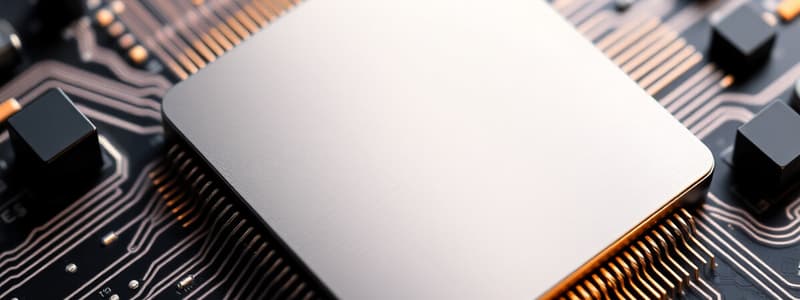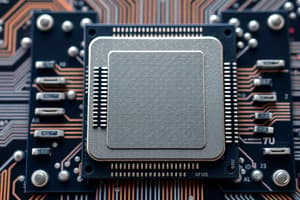Podcast
Questions and Answers
What is the primary role of the Arithmetic Logic Unit (ALU) in the CPU?
What is the primary role of the Arithmetic Logic Unit (ALU) in the CPU?
- To perform arithmetic calculations and logical operations (correct)
- To control the input and output operations
- To store data permanently
- To manage the operating system tasks
Which component of the CPU is responsible for coordinating the steps of processing?
Which component of the CPU is responsible for coordinating the steps of processing?
- Arithmetic Logic Unit
- Random Access Memory
- Control Unit (correct)
- Read Only Memory
What is a defining characteristic of RAM?
What is a defining characteristic of RAM?
- It can only be read and not written to
- It is a non-volatile memory
- It permanently stores data
- It is volatile and temporary (correct)
What is one function of ROM in a computer system?
What is one function of ROM in a computer system?
Which type of memory is characterized by the ability to be written to and erased multiple times?
Which type of memory is characterized by the ability to be written to and erased multiple times?
How does the Control Unit contribute to a computer's processing efficiency?
How does the Control Unit contribute to a computer's processing efficiency?
Which of the following statements about primary memory is true?
Which of the following statements about primary memory is true?
What type of memory would lose its contents when the power is turned off?
What type of memory would lose its contents when the power is turned off?
Which of the following describes a monitor?
Which of the following describes a monitor?
What is the primary function of a printer?
What is the primary function of a printer?
What categorizes impact printers?
What categorizes impact printers?
How do non-impact printers differ from impact printers?
How do non-impact printers differ from impact printers?
Which device is specifically designed to print graphs and charts?
Which device is specifically designed to print graphs and charts?
What is the purpose of a facsimile machine (FAX)?
What is the purpose of a facsimile machine (FAX)?
What role does a sound card play in a computer?
What role does a sound card play in a computer?
Which printing technology uses electrical signals to print without touching the paper?
Which printing technology uses electrical signals to print without touching the paper?
What distinguishes secondary memory from RAM?
What distinguishes secondary memory from RAM?
Which of the following is an example of an optical storage device?
Which of the following is an example of an optical storage device?
What is the typical storage capacity range for hard disks?
What is the typical storage capacity range for hard disks?
Which type of storage device can store the least amount of data?
Which type of storage device can store the least amount of data?
What is a key characteristic of DVDs compared to CDs?
What is a key characteristic of DVDs compared to CDs?
Input/Output devices are important because they allow users to do what?
Input/Output devices are important because they allow users to do what?
Which of the following statements is true regarding hard disks?
Which of the following statements is true regarding hard disks?
What is one primary usage of DVDs?
What is one primary usage of DVDs?
What is the primary function of presentation software?
What is the primary function of presentation software?
Which of the following is a characteristic of machine language?
Which of the following is a characteristic of machine language?
Which programming language is most suitable for writing operating systems?
Which programming language is most suitable for writing operating systems?
What type of software allows for the creation of audio and video content?
What type of software allows for the creation of audio and video content?
How are high level languages typically characterized?
How are high level languages typically characterized?
Which of the following is NOT a type of computer language?
Which of the following is NOT a type of computer language?
What makes assembly language easier to use compared to machine language?
What makes assembly language easier to use compared to machine language?
Which software type is best for executing slide shows?
Which software type is best for executing slide shows?
What are the primary characteristics of high-level programming languages?
What are the primary characteristics of high-level programming languages?
What is the primary function of a compiler?
What is the primary function of a compiler?
How does an interpreter differ from a compiler?
How does an interpreter differ from a compiler?
Why might compiled programs run faster than interpreted programs?
Why might compiled programs run faster than interpreted programs?
What does open-source software allow users to do?
What does open-source software allow users to do?
What is a significant advantage of using an interpreter?
What is a significant advantage of using an interpreter?
What is a drawback of interpreted programs?
What is a drawback of interpreted programs?
Why is high-level language considered more flexible than low-level language?
Why is high-level language considered more flexible than low-level language?
Flashcards are hidden until you start studying
Study Notes
Central Processing Unit (CPU)
- The CPU retrieves data and instructions from storage, performs calculations, and returns results.
- Composed of two main components: Arithmetic Logic Unit (ALU) and Control Unit (CU).
Arithmetic Logic Unit (ALU)
- Executes all calculations and comparisons as per instructions.
- Performs arithmetic operations (addition, subtraction, multiplication, division) and logical operations (greater than, less than, equal to).
Control Unit (CU)
- Manages all operations: input, processing, and output.
- Ensures step-by-step execution of instructions within the computer.
Memory
- Divided into primary memory and secondary memory.
Primary Memory
- RAM (Random Access Memory):
- Temporary storage for the operating system, applications, and current data.
- Volatile and loses content when the computer is powered off.
- ROM (Read Only Memory):
- Non-volatile memory retaining information even when the computer is turned off.
- Contains manufacturer's instructions and the bootstrap loader for system startup.
Output Devices
- Monitor: Displays information, functioning similarly to a TV screen, often using CRT technology.
- Printer: Generates hardcopy outputs.
- Impact Printers: Use mechanical methods (e.g., dot-matrix).
- Non-impact Printers: Utilize chemical, thermal, or electrical methods (e.g., inkjet, laser).
- Plotter: Produces graphical output, used for detailed line drawings and charts.
- Facsimile (FAX): Sends and receives images/text over telephone lines.
- Sound Cards & Speakers: Facilitate audio output for media applications.
Secondary Memory
- Non-volatile storage other than RAM, allowing permanent data retention.
- Includes magnetic devices (hard disks) and optical devices (CDs, DVDs).
Hard Disk
- Consists of rigid platters, providing permanent storage for data and programs.
- Storage capacities typically range from 1GB to over 80GB and are rewritable.
Compact Disk (CD)
- Portable storage medium with a capacity of 650-700MB for audio, video, and text.
- Available in read-only and read-write versions.
Digital Video Disk (DVD)
- Like a CD but with higher storage capacity, often several gigabytes.
- Primarily used for movies and music, typically not rewritable.
Input/Output Devices
- Enable user interaction with the computer by inputting data and outputting processed information.
Computer Languages
- Coded syntax facilitating communication between software programs and the computer.
- Categories include:
- Machine Language: Native binary code directly understood by the CPU.
- Assembly Language: Easier to understand than machine language; suitable for operating systems.
- High Level Language: User-friendly, resembling English, and problem-oriented.
Compiler & Interpreter
- Compiler: Translates high-level language programs to machine language, enabling faster execution.
- Interpreter: Translates high-level instructions into intermediate form and executes them, providing real-time command processing.
Open Source Software
- Source code available to the public for use and modification at no cost.
- Usually developed collaboratively by programmers who improve and share modifications within the community.
Studying That Suits You
Use AI to generate personalized quizzes and flashcards to suit your learning preferences.




